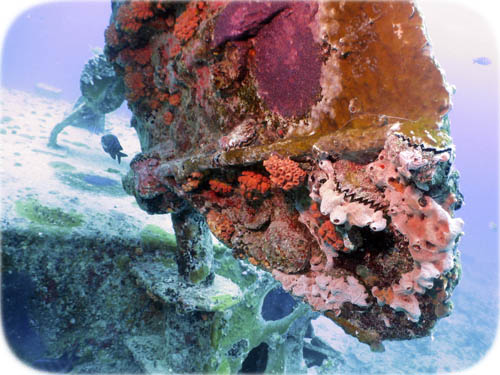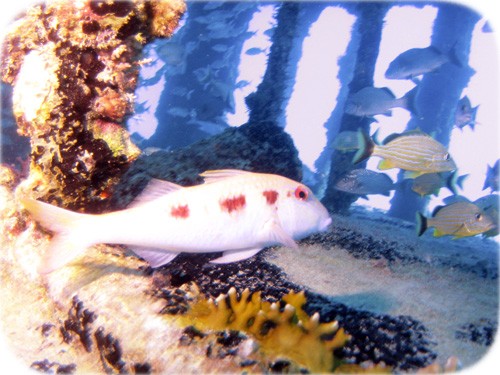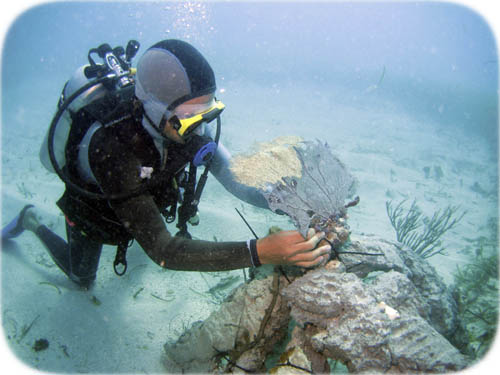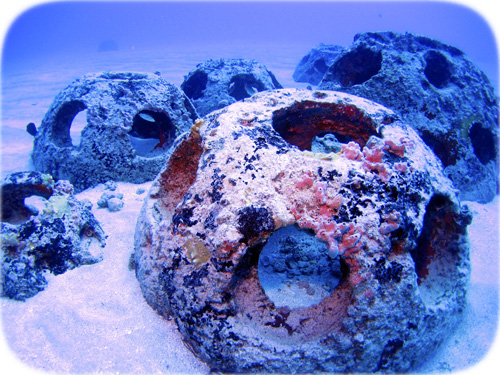October 27th, 2010 by Marc AuMarc
Several members of Les Fruits de Mer (Madam J, Yann, Marie and myself) undertook an expedition to the nearby island of Saba last week for some diving, hiking and, of course, Extreme Shallow Snorkeling. Over the next few days I’ll be posting all about our adventures.
Saba is a much younger island than St. Martin, I believe about ten million years younger, or about half the age of St. Martin. While both islands are originally volcanic, St. Martin was submerged and capped with limestone, while Saba is basically still just a volcano jutting straight out of the ocean. It’s about a seventh the area of St. Martin, but twice as tall.
This post features some photos from our first day of diving on the island. The world-famous diving is the primary tourism draw of the island. Our first dive was at a site called Outer Limits, which is one of the pinnacle dives. The underwater pinnacles are basically submerged mountaintops off the coast of Saba that rise to between 90 and 110 feet below the surface of the ocean. Although the depth means short dives, these unique formations are a big attraction to divers.
Our next dive was at a site called Ladder Labyrinth, which primarily consists of coral and sponge encrusted underwater lava flows that create a variety of interesting structures. Underwater hot springs leave sulfur patches in the sand, and geothermal heat can be felt if you put your hands into the sand in the right spots.
We were also lucky enough to arrive during the month-long Sea and Learn event, which includes talks by experts and hands-on research opportunities. We went on a dusk/night dive with Graham Forrester to see if we could watch hamlets spawn. Although we didn’t actually see this because there aren’t very many hamlets in the waters around Saba, we did have a great night dive. One highlight was a nurse shark which followed us everywhere, probably because our flashlights helped it find prey.
It was a busy day and a great way to start our expedition!
Tags: diving, saba, scuba
Posted in Adventure and Excitement, Diving, Explorations, On Expedition
Comment on this post.
February 20th, 2009 by Marc AuMarc
Artificial reefs are man made structures placed underwater to promote reef formation. There are many kinds of artificial reef, ships being perhaps one of the most common, either inadvertently shipwrecked, or deliberately sunken after being cleaned and towed to the desired site. Artificial reefs are also made from cars, and retired subway cars.
Artificial reefs provide a substrate upon which corals, sponges and mollusks can grow. For example, this rudder has been encrusted with a variety of growth:

Artificial reefs also provide shelter for a variety of fish species. The structure provides shelter from predators, much like the recesses and crannies in a natural reef:

Concrete is a popular artificial reef material because it is inexpensive, and provides a good substrate for coral growth. In the photo below, J.P. (The Lion of the Sea) is adjusting starter coral attached to a small concrete artificial reef substrate. Notice that the structure has holes to allow the flow of water, otherwise it would be destroyed by the surge. As it turns out, this artificial reef structure was destroyed, most likely because, at 25 feet, it was not protected enough from the waves, tides and surge.

Below is a photo of a number of concrete reef pods near the wreck of the Ro/Ro off the coast of Sint Maarten. While you can see growth on these pods, coral and other reef-building organisms take time to become established.

Chris and Sally from Octopus Diving and Snorkeling in St. Martin hope to start artificial reef programs on the French side of the island, hopefully using grants or sponsorships to cover the cost of creating and deploying the pods. Sponsors may even be able to have a plaque on their undersea pod commemorating their contribution! We’ll let you know as plans unfold.
Tags: artificial reef, diving, Marine Ecology, reef pods, underwater
Posted in Marine Ecology
Comment on this post.





























